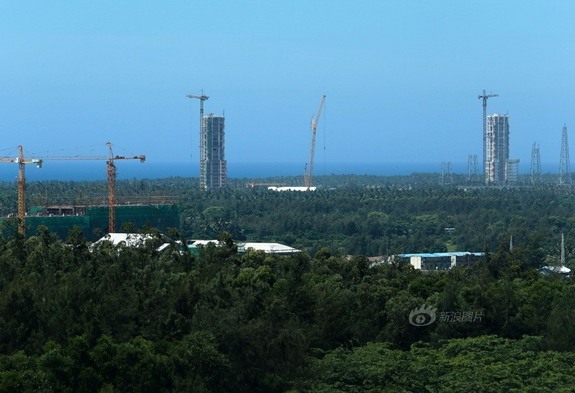The Long March 7 is a Chinese kerosene fueled carrier rocket, which is being developed by the China Aerospace Science and Technology Corporation. Its maiden flight is scheduled for 26 June 2016
The Long March 7 is the medium-lift variant of a new generation rocket family that includes the heavier-lift Long March 5 and the small-mid cargo Long March 6. The structure will be based on the reliable, man-rated Long March 2F rocket. It will inherit the 3.35m-diameter core stage and 2.25m-diameter liquid rocket boosters.
China will also be switching from russian Soyuz style capsules to something like the American Apollo capsules.
The goal is to build a more cost-effective and less hazardous rocket family to replace today’s Long March 2 and eventually the Long March 3. It will be capable of placing a 5,500 kilograms (12,100 lb) payload into a sun-synchronous orbit.
With payloads cited in the 10-20 ton, it will use two YF-100 engines in the core stage and one YF-100 engine for the four liquid rocket boosters.
The Long March 7’s maiden flight will not only test the new rocket and a next-generation human-rated spacecraft. It will also mark the first use of a new island spaceport in the South China Sea.
Rocket components slated for the Long March 7’s inaugural flight left port at Tianjin, China, on May 8, heading to the launch base on Hainan Island off China’s southern coast
Flights from the Hainan spaceport, named the Wenchang Satellite Launch Center, will drop spent rocket stages over the ocean instead of on land. Built between 2009 and 2014, the launch center sits at 19 degrees north latitude, closer to the equator than any other Chinese rocket base, giving China better access to place satellites in geostationary orbit.
Wenchang launch center
China also plans to use the new spaceport for interplanetary missions, including the Chang’e 5 robotic lunar probe, which aims to return samples from the moon as soon as next year.
Hainan island
China plans to replace its current outdated rockets — based on decades-old designs — with a new fleet of Long March 5, 6 and 7 boosters.
The conical spacecraft capsule is similar to the American Orion and Apollo capsules and would be capable of carrying between two and six crew members. The capsule would be attached to service modules of different sizes depending upon the mission.
CCTV has paid a visit to the manufacturing base in Tianjin, where the new-generation carrier rocket, the Long March-7, had been assembled. The rocket has been built with environment concerns in mind; it uses kerosene and liquid oxygen as fuel to reduce air pollution. Designers have also opted for equipment that uses ‘brain-like’ computer chips, which are able run tests of their own.
If the Long March 7 launch is successful this will increase the activity at the Hainan Space flight center. It could accelerate the need for heavy cargo lift. This could ensure that China does a deal with Ukraine for the completion of an Antonov 225 superheavy cargo plane.
A superheavy lift cargo plane would be useful for moving large rocket parts.
SOURCES- Wikipedia, CCTV, Youtube, Parabolic Arc, Spaceflight Now

Brian Wang is a Futurist Thought Leader and a popular Science blogger with 1 million readers per month. His blog Nextbigfuture.com is ranked #1 Science News Blog. It covers many disruptive technology and trends including Space, Robotics, Artificial Intelligence, Medicine, Anti-aging Biotechnology, and Nanotechnology.
Known for identifying cutting edge technologies, he is currently a Co-Founder of a startup and fundraiser for high potential early-stage companies. He is the Head of Research for Allocations for deep technology investments and an Angel Investor at Space Angels.
A frequent speaker at corporations, he has been a TEDx speaker, a Singularity University speaker and guest at numerous interviews for radio and podcasts. He is open to public speaking and advising engagements.






